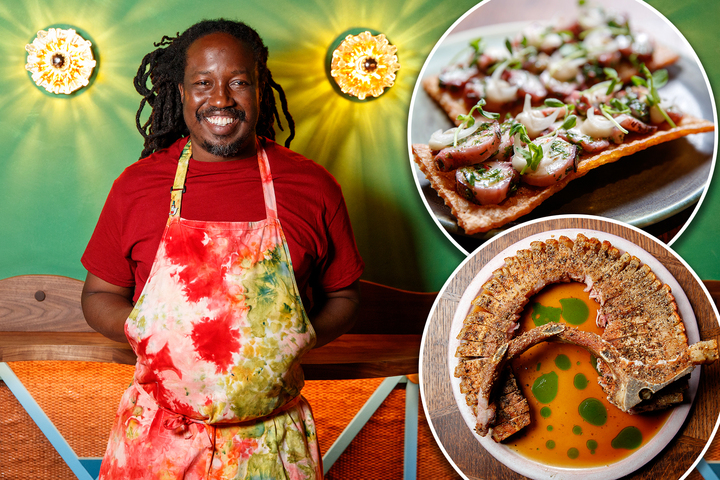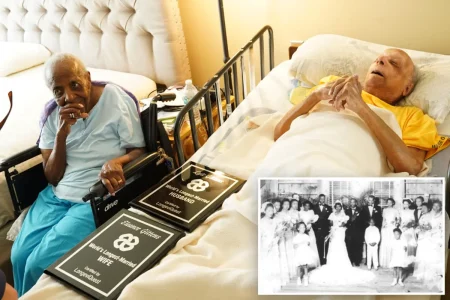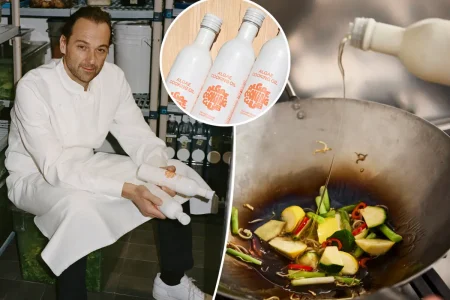Kabawa: A Caribbean Culinary Journey in the East Village
In the East Village, at the unique address of Extra Place, a culinary transformation has taken place. Momofuku Ko, once David Chang’s nearly inaccessible temple of gastronomy, has given way to Kabawa, a vibrant celebration of Caribbean cuisine. This transition marks a significant shift in Chang’s Momofuku empire, which has been contracting its sit-down restaurants for the past two years while expanding into consumer products. However, while the space may be the same, the experience at Kabawa is entirely different – exchanging Ko’s extended Asian-influenced tasting menu for a concise three-course Caribbean journey that still manages to capture the adventurous spirit of its predecessor.
The physical space retains some of its industrial edge, but chef Paul Carmichael has infused it with brighter colors, mosaics, and most importantly, his infectious warmth and enthusiasm. While the scattered tables offer a quieter dining experience, the three-sided counter surrounding the open kitchen provides the true heart of Kabawa. Here, guests mingle easily with strangers as they watch Carmichael work his magic with a perpetual smile. The chef’s personable nature creates an immediate connection with diners – when I mentioned honeymooning in his native Barbados years ago and experiencing repetitive flying fish dishes, he responded with a knowing chuckle and a twinkle in his eye, noting that “We have real Bajan food festivals now.” This brief exchange perfectly captures the spirit of Kabawa: respectful of tradition while moving Caribbean cuisine forward.
Kabawa’s prix-fixe menu, priced at $145 (with optional supplements that can significantly increase the total), draws inspiration from across the Caribbean archipelago – Barbados, Jamaica, Trinidad, Martinique, Puerto Rico, and beyond. Yet Carmichael, who previously worked at Chang’s former establishment Ma Peche, isn’t attempting to create a generic “pan-Caribbean” experience. Instead, he offers his personal interpretations of dishes that resonate with him, carefully avoiding tourist clichés. You won’t find traditional jerk chicken here, though a hearty duck sausage “inspired” by jerk seasonings makes an appearance. The flavors are authentically tropical without resorting to the predictable overuse of pineapple and coconut that often characterizes Caribbean food in American restaurants.
The dining experience begins with an impressive bread service featuring two distinct offerings: flaky Trinidad-inspired roti that invites hands-on enjoyment and firm Jamaican cassava cubes. These are accompanied by an array of vibrant dips – pepper jelly, plantain ginger chutney, curried chickpeas, and mango chutney – which provide a delightful preview of the flavor journey ahead. The subsequent dishes continue to impress with their thoughtful execution and bold flavors. Black sea bass appears deceptively simple alongside a pool of mild Trinidadian curry but delivers remarkable depth of flavor. Breadfruit tostones serve as a base for tender octopus rings, enhanced by “dog” sauce – a vibrant condiment from the French Caribbean combining parsley, lime, and habanero. Raw Montauk pepper shrimp dusted with hibiscus and fermented Scotch bonnet peppers achieve perfect balance, though they’ve since been replaced by equally impressive ocean scallops with a pronounced mineral quality. A standout combination of plantain-scrambled egg and salt cod proves so delicious that the optional caviar supplement (adding $50 to the bill) feels entirely unnecessary – the creamy scramble and sweet salt cod shine brilliantly on their own.
Not every dish reaches these heights, however. The chuletas can can – a spectacular Puerto Rican pork presentation combining rib, belly, and loin seasoned with recaito (a traditional sofrito of pepper and cilantro) – commands attention with its impressive appearance and $75 supplement. Unfortunately, it disappoints in execution, with meat that emerges too dry and lacking the textural contrasts one would expect from such different cuts. This misstep stands out primarily because the overall standard at Kabawa is so high. The beverage program complements the food beautifully, featuring reasonably priced wines and an impressive selection of premium rums. A Cuban-inspired daiquiri made with shaved ice proves particularly refreshing alongside the bold flavors of Carmichael’s cuisine.
For those curious about Kabawa but hesitant to commit to the full prix-fixe experience, the adjacent Bar Kabawa offers an accessible introduction to Carmichael’s culinary vision. Its a la carte menu features “small bites” and various patties filled with goat, shrimp, and crab, prepared through different cooking methods. These provide an affordable gateway to understanding the chef’s talent. However, to fully appreciate the scope of Carmichael’s abilities and the joyful spirit he brings to Caribbean cuisine, the main restaurant remains the destination of choice – particularly at the counter, where the combination of culinary theater and communal dining creates a truly special experience. Kabawa may occupy the same physical space as Momofuku Ko, but it has established its own distinct identity: less concerned with gastronomic pretension and more focused on genuine hospitality and the vibrant celebration of Caribbean flavors. In doing so, it honors the innovative spirit of its predecessor while charting an entirely new and exciting culinary course.















